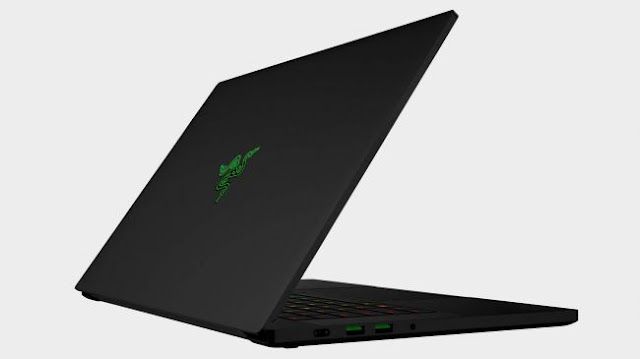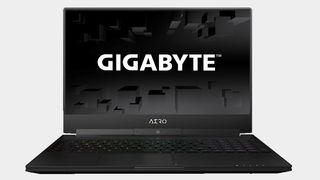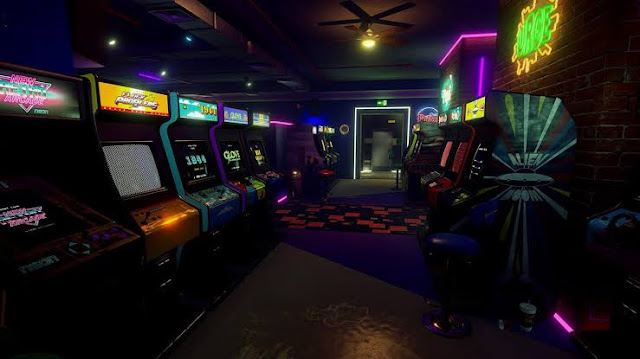Stealth Thin
Elegant. Portable. Powerful. The best gaming laptop you can buy
CPU: Intel Core i7-8750H | GPU: Nvidia GeForce GTX 1070 Max-Q | RAM: 16GB DDR4-2400MHz | Screen: 15.6-inch FHD (1,920 x 1,080) wide-view 144Hz | Storage: 512GB M.2 SSD | Battery: 82 Whr | Dimensions: 9.75 x 14.08 x 0.69 inches | Weight: 4.14 lbs
Sleek and powerfulLong battery lifeNo G-Sync
The GS65 Stealth Thin delivers everything I want in a gaming laptop. It has the convenience and portability of a productivity notebook—light and thin enough that I can toss it in my backpack, tote it to meetings, and comfortably use it on the couch—married with the internal guts of a gaming PC—powerful enough to play the latest games at high or max settings once the workday is over.
It has a sleek matte black aluminum body with gold accents that feels sturdy and luxe—and thankfully lacking in obnoxious gamer aesthetics. Best of all, in addition to a slim, 18mm thickness, the screen's 4.9mm thin bezels allow for a overall chassis size that's about an inch smaller than most 15-inch laptops.
Performance-wise, the GS65 doesn't disappoint. The base spec features a GTX 1060 Max-Q GPU, but I recommend the GTX 1070 (again Max-Q) model for a few hundred dollars more. It brings with it an upgraded SSD and Killer wireless networking. This spec lets the GS65 maintain framerates above 60 fps in most of the latest games with settings maxed out. And by tweaking a few settings and disabling some of the more demanding, less visually-impactful options, you can easily push your framerates up to 100 fps and above, taking advantage of the system's 144Hz display.
> Acer Predator Helios 300

CPU: Intel Core i7-7700HQ | GPU: Nvidia GeForce GTX 1060 6GB | RAM: 16GB DDR4-2133MHz | Screen: 15.6-inch FHD (1,920 x 1,080) wide-view 60 Hz | Storage: 256GB M.2 SATA SSD | Battery: 48 Whr | Dimensions: 10.47 x 15.35 x 1.05 inches | Weight: 5.95 lbs
Incredible valueDecent battery lifeOnly red backlightingGaudy aesthetics
Acer's Predator Helios 300 offers an incredible value proposition. At just over a grand, sometimes less if you can find it on sale, it offers a GTX 1060 6GB graphics card that can lock down 60 fps at near-max settings in most games from the last few years. The system's lacking in any fancy screen features like a high refresh rate or G-Sync, and you'll probably want to think about investing in a large HDD to back up the 256GB SSD. But those minor issues don't mean much when you factor in the super-affordable price tag. The Acer Predator Helios 300 is the best budget gaming laptop you can buy.
> Razer Blade 15

Solid construction, slim body, elegant design
CPU: Intel Core i7-8750H | GPU: Nvidia GeForce GTX 1070 Max-Q | RAM: 16GB DDR4-2666MHz | Screen: 15.6-inch FHD (1,920 x 1,080) IPS 144Hz | Storage: 512GB SSD | Battery: 80 Whr | Dimensions: 9.25 x 13.98 x 0.68 inches | Weight: 4.63 lbs
Beautiful constructionThinnest gaming laptop we've testedVapor chamber coolingNo Ethernet port
With the new Blade 15, launched earlier this year, Razer has finally caught up to the competition in terms of what makes a great gaming laptop. Solid construction, slim body, elegant design, long battery life, thin bezels, 144Hz screen, and internals powerful enough to play the latest games. That means an Intel Core i7-8750H processor paired with an Nvidia GeForce GTX 1070 Max-Q GPU.
What sets the Blade 15 apart from the competition is the details. Its aluminum body is the most solid and flex-resistant of all the laptops we've tested lately, and by a measure of about half a millimeter, it's the thinnest as well. Of course, that half-millimeter difference is mostly negligent in terms of perception—more impressive is the overall solid feel of the body, which Razer says is CNC-milled from a single block of aluminum. Opening the clamshell, the touchpad is noticeably larger than its peers, and the keyboard is flanked on either side by large speakers.
> Gigabyte Aero 15X v8
Productivity powerhouse with longer battery life
CPU: Intel Core i7-8750H | GPU: Nvidia GeForce GTX 1070 Max-Q | RAM: 16GB DDR4-2666MHz | Screen: 15.6-inch FHD (1,920 x 1,080) IPS 144Hz | Storage: 512GB SSD | Battery: 94 Whr | Dimensions: 9.8 x 14.0 x 0.74 inches | Weight: 4.49 lbs
Gigabyte's Aero 15X was the first thin Max-Q laptop to catch my eye, and the 2018 Aero 15X v8 refresh remains a promising entry in the field, fixing most of the issues I had with its predecessor while keeping everything else that I love about it. Primarily, the keyboard works much better after a driver update, and the screen's been updated to a snappy 144 Hz panel.
Compared to MSI's GS65 and the Razer Blade 15, the Aero 15X has a less attractive body with sharp edges, but wins in the productivity category on account of a bigger, 94 Whr battery. In practice—that is, our streaming video test—that larger battery lasts upwards of six hours, compared to the GS65's four and a half. With near-identical internals, gaming performance is comparable to the GS65 as well. The biggest difference, other than the body design and battery, is that the Aero 15X can be outfitted with a 4K screen. I recommend sticking with the high refresh rate 1080p screen if gaming is your primary concern, but 4K is a nice option for productivity power users who can take advantage of the extra pixels.
> Asus ROG Strix GL503VS-DH74 Scar Edition
Bigger body, better performance
CPU: Intel Core i7-7700HQ | GPU: Nvidia GeForce GTX 1070 | RAM: 16GB DDR4-2400MHz | Screen: 15.6-inch FHD (1,920 x 1,080) wide-view 144Hz with G-Sync | Storage: 256GB NVMe SSD, 1TB FireCuda SSHD | Battery: 64 Whr | Dimensions: 10.3 x 15.2 x 1.0 inches | Weight: 5.6 lbs
Full-power (non Max-Q) GTX 1070Great SSDBulkyPoor battery life
I said at the beginning that choosing a laptop usually means picking two between price, performance, and portability. Where thin-and-light laptops like the GS65 offer the latter two of those three, the Asus ROG Strix GL503VS-DH74 Scar Edition instead checks the first two boxes: price and performance.
In exchange for a larger shell, the GL503VS packs in a regular (non Max-Q) GTX 1070 GPU. This results in a performance improvement of around 15 percent at a slightly lower price point. It uses a previous gen quad-core CPU, but that doesn't matter in most games. The GL503VS also offers G-Sync on its 144Hz panel, but the tradeoff means you miss out on Nvidia's Optimus battery tech. As such, you shouldn't expect more than around two hours of battery life. Don't forget your charger!
Source : PCGamer
Source : PCGamer

.png)



















No comments:
Post a Comment